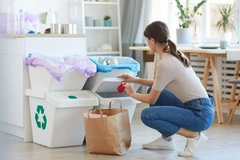European Bioplastics Conference: Kaneka manager pinpoints lacking legislative support as industry’s biggest challenge

26 Nov 2021 --- While bioplastics innovation continues to thrive globally, Erwin Lepoudre, market development manager for biopolymers at Kaneka Belgium, insists market growth would accelerate if regulation differentiating biodegradable plastics from conventional petrochemical plastics was introduced.
Kaneka is a Japanese-headquartered biodegradable polymer producer specializing in Polyhydroxyalkanoates (PHAs), a natural biopolymer produced through vegetable oil fermentation.
Ahead of the 16th European Bioplastics Conference in Berlin, Germany, next week, PackagingInsights sits down with Lepoudre to discuss how improved regulation could support bioplastics’ market growth as brands and consumers search for petrochemical plastics alternatives.
Meanwhile, intellectual property firm Appleyard Lees has revealed an uptick in bioplastic patent filing activity in its “Inside Green Innovation: Progress Report 2021.” The growing interest is particularly apparent in Europe, Japan and South Korea.
Regulatory recognition
Lepoudre echoes the concerns of the bioplastics sector at large, highlighting that legislation, notably the EU Single Use Plastics Directive (SUPD), does not differentiate between biodegradable or compostable plastics and petrochemical plastics.
However, Italy is one country making exemptions for biodegradable and compostable plastics in its SUPD transposition. The decision prompted environmental campaigners to report the Italian government to the European Commission.
For Lepoudre, lacking legislative support is the biggest challenge to bioplastic market growth. He calls for the following changes:
- Regulating the organic recyclability of biodegradable plastic applications, including harmonization across Europe.
- Supporting criteria and standards for applications also recoverable through anaerobic digestion and home-composting.
- Supporting criteria and standards for biodegradability in the marine environment.
- Supporting the use of bio-based and renewable resources for plastics manufacturing, helping achieve a greenhouse gas emission-neutral society, equivalent to recycled content promotion.
- Installing industrial-scale composters and anaerobic digesters globally. Here, the EU is “quite advanced,” he notes.
Kaneka’s PHA prowess
Kaneka’s “Green Planet” PHA can be processed with conventional plastic industry equipment, such as injection molding, blow molding and extrusion machinery. “The typical end applications are those for which organic recyclability (compostable and anaerobic digestibility) is the intended end-of-life, or for which it is challenging to avoid fragments ending up in the open environment,” explains Lepoudre. Kaneka’s biodegradable shopping bag for Jalux stories in Japan.
Kaneka’s biodegradable shopping bag for Jalux stories in Japan.
The company’s partnerships are mostly confidential. However, Lepoudre shares the company is supplying cosmetics packaging to Shiseido Company, straws to Seven Cafés and Itoen, shopping bags to Jalux, and spoons to Famima.
“The [PHA] material is based on natural sources,” he continues. “Additionally, programs are ongoing to also use recycled cooking oils.”
Biodegradable benefits
Moreover, the PHA is certified biodegradable in soil and marine environments. “Biodegradable packaging recoverable through composting or anaerobic digestion can help to divert organic waste from landfill, create biogas, make soils healthier and reduce fugitive methane emission,” adds Lepoudre.
“While critics suggest biodegradable bioplastics potentially contaminate existing recycling streams, it is also understood conventional plastics contaminate organic waste streams,” he argues.
“Studies have shown that, at this stage, compostable plastics do not enter the waste stream to cause concern. Also, they can be sorted with conventional equipment.”
Bioplastic innovation proliferates
According to Appleyard Lees’ report, trends in bioplastic patent filings indicate innovation is thriving. Moreover, the intellectual property firm suggests patent filing activity is unlikely to slow down due to “legislative pressures to increase bioplastics use in consumer goods, especially short-life goods.” Kaneka’s PHA spoons used by FamilyMart’s Famima convenience stores.
Kaneka’s PHA spoons used by FamilyMart’s Famima convenience stores.
The increasing innovation is translating into market growth despite the “unfavorable legislation.” At the last European Bioplastics Conference, the association and nova-Institute estimated 36% growth in the bioplastics market over the next five years, after the sector “successfully weathered COVID-19 challenges.”
Meanwhile, the organizations confirmed Asia remains a major hub of bioplastics activity with over 46% of the production share. Bio-based PP and PHAs were identified as major growth areas.
Appleyard Lees says creating functional and inexpensive bioplastics presenting a viable alternative to existing polymers are the major challenges for bioplastic innovators.
PackagingInsights also discussed the bioplastics market with suppliers Sukano and NatureWorks ahead of the European Bioplastics Conference (30 November to 1 December).
By Joshua Poole











